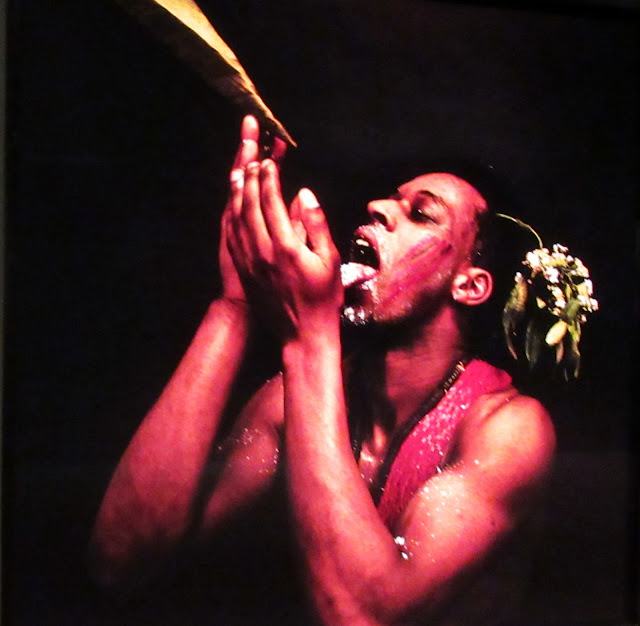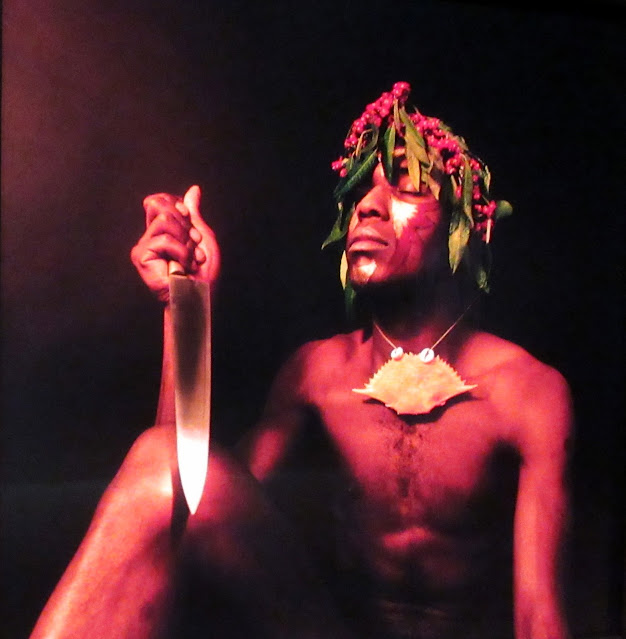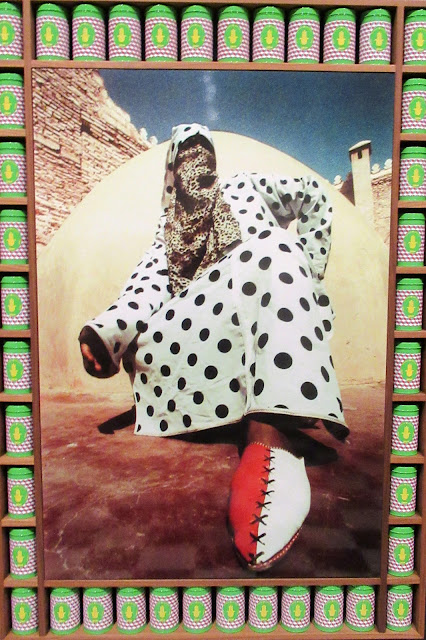'Africa has always been the object of discourse by others. Now it is time to dream this utopia in Africa itself, to design Africa ourselves, to think, and to act for ourselves'.
A world in common - contemporary African photography

We went to see this exhibition last year, and I have just managed to write the post for it. It was wonderful 're-living' all the images and seeing it with 'fresh' eyes.
The exhibition brings together 36 artists who use photography to reimagine Africa's place in the world. It is inspired by the continent's rich cultural traditions, as well as present-day social and political realities. Drawing on the theories of Cameroonian philosopher Achille Mbembe the exhibition invites us to imagine 'a world in common'. To do this, Mbembe claims 'we must think the world from Africa'. The exhibition explores Africa's past, present and future to create a more expansive and inclusive narrative of humanity. It suggests that to conceive 'a world in common' is to imagine a future of possibility.
There is no single, definitive history of Africa. It is a continent of multiple, interconnected realities. Pushing the boundaries and photography and film, the artists in this exhibition confront reductive representations of African peoples and cultures. They address photography's past and embrace its potential to reframe the present and shape tomorrow.
This section is rooted in ancient African cultures and traditions which have survived periods of struggle and resistance.
From the 16th century, Europeans enslaved more than 10 million Africans, abducting them from their homes and their cultural heritage. This history of enslavement, violence and colonialism reached its height in the 19th century. Through a combination of nationalistic competition, extreme racism and automatic weeaponry, European powers conquered 90% of Africa by 1914. In this first section artists pay tribute to the monarchs and matriarchs who resisted this violence.
George Osodi, Nigerian Monarchs series, 2012-22
George Osodi, Nigerian Monarchs series, 2012-22
Spiritual Worlds:
Spirituality in Africa is as complex and diverse as the continent itself. Traditional religions often revolve around philosophical questions of existence and being, explored through sacred myths and rituals.
During the colonial period, European missionaries sought to 'convert' communities, suggesting their religions were rooted in anti-Christian values. Figures like the Kenyan philosopher and Anglican priest John Mbiti challenged these stereotypes. He argued that African religions deserve the same respect as Abrahamic faiths. Ultimately, these spiritual traditions survive, preserving the ability to connect the living and spirit worlds.
Here, the artists examine ritual as a source of healing and a way to connect with communities near and far, real and imagined. Through their practices, these artists consider spirituality as a personal journey towards a shared humanity beyond cultural, religious and political borders.
This work explores the relationship between isolation and togetherness that can be experienced when practising religion.
Rotimi Fani-Kayode, Bodies of Experience, 2023
Men in floral headpices and fetish wear, performing Yoruba rituals and acts of devotion inspired by the 'technique of ecstasty' practised by Yoruba priests to transcend their physical realities.
Zina Saro-Wiwa, The Invisible Man series, 2015 (3 photographs, inkjet print on paper)
Worrying the mask:
Masks are a significant part of African cultural heritage, playing an important role in ritual and ceremonial performances across many regions. For centuries, they have been used to form relationships between individuals, communities, the environment and the cosmos. By putting on a mask, performers enter a sacred realm between the living and ancestral worlds.
During the 19th and early 20th centuries, masks were removed from these spaces of ritual and taken to Europe where they became museum objects. Here, contemporary artists engage with their heritage while challenging these histories of dispossession.
Zina Saro-Wiwa, The Invisible Man series, 2015 (3 photographs, inkjet print on paper)
Zina Saro-Wiwa, The Invisible Man series, 2015 (3 photographs, inkjet print on paper)
Wura-Natasha Ogunjji, Will I still Carry Water when I am a Dead Woman, 2013, (single-channel digital video)
Ogunji and six other women drag kegs of water, strapped to their ankles, leaving trails of water behind them. 'While the piece poses questions about the work of women,it is also about labour and the politics of change. How much is enough? What is the tipping point in a society where people struggle to meet basic needs? When do people have an opportunity to rest, reflect, envision, imagine and enact another way of being?'
Edson Chagas, Tipo Passe series, 2014
In this series, Chagas photographs sitters wearing masks and contemporary clothing against a stark white background. The title, Tipo Passe, is Portuguese for passport and the artist's frontal composition references passport photography. Chagas photographs a variety of traditional Bantu masks used to represent the spirits of ancestors. Questioning the collection and display of these masks as cultural artefacts divorced from their intention, Chagas explores the connection between their intended use as performative objects and the global circulation of traditional African art.
This section of the exhibition looks at counter histories where the camera's ability to challenge the colonial gaze and produce alternative images of the past is explored.
In the 19th century, photography became a valuable tool for colonial powers. Ethnographic images of African peoples and landscapes were distributed through postcards and magazines. They 'othered' subjects and created racist stereotypes that legitimised the mission of empire. These works honour a long history of studio portraiture that gives agency to African photographers and their sitters, interrogate colonial archives and uncover hidden histories.
Ndidi Dike, A History of a City in a Box, 2019, (5-3 paper-covered wood box files, 10 inkjet prints on paper, 9 bound documents, and sand)
Dike's installation brings together hundreds of discarded file boxes designed to protect and conceal information. She fills them with archival documents, including colonial-era postcards and photographs and surrounds them with sand and soil. 'Information is one of the greatest currencies in Lagos', Dike explains. 'Information is hidden and buried; it is inaccessible to the people, and only permitted to those in power. You know this is really a holdover from the colonial era... I think information is the foundation on which cities are built, it's the way they operate, how power is generated, how inequality prevails'.
Malala Andrialavidrazana, Figures 1861, Natural History of Mankind, 2016
Maps, fragments of bank notes, record sleeves and other archival documents are assembled to produce complex, layered digital collages. Andrialavidrazana combines imagery from different times and places, considering identity from a syncretic perspective.
On her use of maps, she notes that 'cartography was among the most powerful political and ideological tools during the 19th century'. By deconstructing these documents of pre-colonial and colonial land use, the artist questions their authority and also acknowledges their ongoing impact. Adrialavidrazana invites us 'to look back in order to move forward'.
Elephant Quilt, 2021, (sewn polyester and cotton on wood)
Kambalu's cardboard cut-outs are of African soldiers who fought for the British Empire during WWI and WWII and were known as the King's African Rifles. The artist uses cardboard to reference their expendable status to colonial powers.
The fabric 'quilt' consists of grahic images that recall abstract geometric patterns and Kuba textiles. The multi-national designs become symbols of a global disporic community. Kambalu says, 'I believe in people, I'm not too sure about countries'.
Hassan Hajjan, White Dotted Stance, 2002, (photograph, digial C-print on paper mounted on aluminium and tea boxes)
In this series, Hajjaj photographs a community of women he calls the Kesh Angels (named after the Hells Angels and the city's motorbike culture). In their vivid djellabas and veils, his portraits portray proud and independent Muslim women. Drawing inspiration from the patterns of Islamic decorative arts, Hajjaj places his pictures inside custom frames inset with tin cans and bottles.
He explains, 'I wanted to show the world what I saw of the country and its people - the energy, the attitude; the inventiveness and glamour of street fashion; the fantastic graphics on every day objects and products; people's happy outlook and strength of character'.
Imagined Futures - Shared Dreams:
In this section, artists contemplate futures shaped by globalisation and the climate emergency. In times of crisis, they find inspiration in the promise of new worlds and shared dreams for a new society. Dispensing with colonial visions of Africa, they turn to the 'planetary', where humans, technology and the natural world come together to form interconnected ecosystems. They explore how urbanisation has transformed the continent and its ways of life.
Shifting geopolitics and plentiful resources mean Africa's economic growth is now predicted to outpace the rest of the world. However the exploitation of natural and human resources has left the continent caught between the promise of a brilliant future and an uncertain present. In recent years natural disasters, extreme weather and mass migration have put the future of our planet into focus. While global in reach, these issues disproportionately affect citizens of the Global South. Here, artists address this uncertainty by turning to their environment. They face the consequences of humanity's self-destruction and explore alternative ways of being.
The Fortress, tells the story of unfinished and derelict areas of cities across the globe. Henda reflects on practices that see buildings left vacant while so many experience homelessness.
Kiluanji Kia Henda, (The City Skyline), 2013, (photographs, inkjet print on paper)
Aida Muluneh, Water Life Series, 2018, (photograph, inkjet print on paper)
The Shackles of Limitation, 2018, (photograph)
Steps, 2018, (photograph)
The Sorrows We Bear, 2018, (photograph)
In this series, Mulubeh explores rural water access and its impact on women's rights, well-being and education. While living in Ethiopia, she encountered women travelling for hours by foot while carrying heavy vessels of water. With the rise of extreme weather events caused by climate change, access to clean water is becoming a widespread issue. Droughts make its availability unpredictable, while flooding threatens the contamination of supplies.
Using a striking palette of bright blue and red, Muluneh incorporates traditional African body painting and dress as a celebration of the beauty and culture of the continent. 'The world is continually bombarded with the social plight of Africa, therefore my focus in this project was to address these topics without the cliche that we see in mainstream media. In a sense, to advocate through art'.
An ongoing series examining the ever-changing architecture and landscape of Lagos, Nigeria.
Monteiro's series captures environmental issues facing communities in Dakar, Senegal, from forest fires to coastal erosion. Spiritual figures emerge from rubbish dumps, discarded fishing nets and burning landscapes. They are inspired by West African masquerade and animism, the belief that objects and the natural world are imbued with spirits. Their elaborate costumes, made of rubbish and natural materials, envoke the environmental consequences of excessive consumption. The figures appear to deliver a message of warning. 'My work is about unity, abour revealling the ways in which we are connected, to each other and to nature', the artist explains. 'I seek to build bridges between all for a more comprehensive approach to this unprecedented challenge in the history of humanity'.
Fabrice Monteiro, The Prophecy series, 2013-15 (inkjet print on paper)
Dawit L. Petros, The Stranger's Notebook series, 2016
The Stranger's Notebook explores geographical, historical and cultural boundaries. In the series, Petros documents his travels from Africa to Western Europe, reflecting on a long history of migration. Passing through cities the artist considers the migrants, refugees and asylum seekers who make treacherous journeys between the two continents. Petros photographs his companions and local people holding mirrors to the landscape, revealing reflections of coastlines, train tracks and power lines. Conscious of his own position as an outsider in these spaces, the artist positions himself as a 'stranger', photographing his staged compositions from a distance. Petros comments: 'for me, each of these journeys complicated Europe's status as an immutable historically and politically bounded space. I negotiated these journeys conscious that I came from elsewhere'.
Epilogue : Imagined Futures:
In the final room of the exhibition, two artists take us on journeys through forests, across oceans and along migratory paths. They consider how the natural environment fosters conditions for growth and rebirth. These artists address nature as a dynamic and generative force, inviting us to imagine new ways of inhabiting the earth.
Throughout the exhibition, artists have pursued a shared humanity through the concept of 'a world in common'. Their expansive and inclusive approach to story telling makes space for different ways of thinking and being in the world. By acknowledging there is no single site for the production of knowledge, these artists imagine multiple futures.
In his 2016 book Afrotopia, Senegalese academic Felwine Sarr calls for 'Africans to think and formulate their own future'. He says: 'Africa has always been the object of discourse by others. Now it is time to dream this utopia in Africa itself, to design Africa ourselves, to think, and to act for ourselves'.
In this ongoing multimedia project nature is presented as a living force or a 'chraracter with its own will and power, like an open book that tells the story of humanity and the planet, with Congo at its centre'. Humanity's role becomes one of witness rather than protagonist.
Julianknxx, In Praise of Still Boys, 2021, (video)
In Praise of Still Boys explores connections between the African diaspora, the Middle Passage, and Freetown, Sierra Leone, Knxx's birthplace. Freetown was founded in 1792 as a 'haven' for formerly enslaved Africans living in England, Canada and Jamaica. It became home to a community of people looking to reclaim agency and identity. Knxx and his family are descendants of these freedom seekers, known as Krios (Sierra Leonean Creoles). The film opens with his mother speaking Krio, telling the story of his birth. Aged 9, Knxx and his family were forced to flee Freetown due to the civil war. They settled in London where he is still based. 'People ask why I'm so fixated on Freetown', he says. 'But I'm not telling a West African story, I'm telling a global story - it's a global history'.
























































Wow. A lot in this blog post.
ReplyDeleteI also liked those part of the "Water Life Series".
The lagos paintings by Andrew Esiebo of the "Mutations series" show an ugly beauty in metropolis cities. The last one with yellow taxis can look like some abstract work which speaks to the inherent abnormality of heavy-density city life.
Thanks for your comment Liam. It was a great exhibition, I really enjoyed it.
Delete